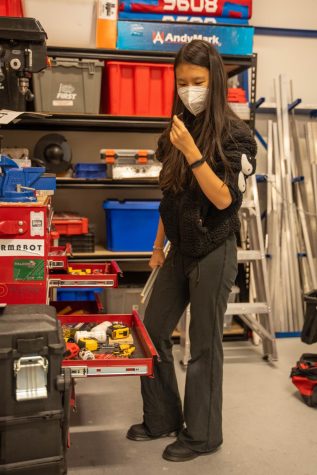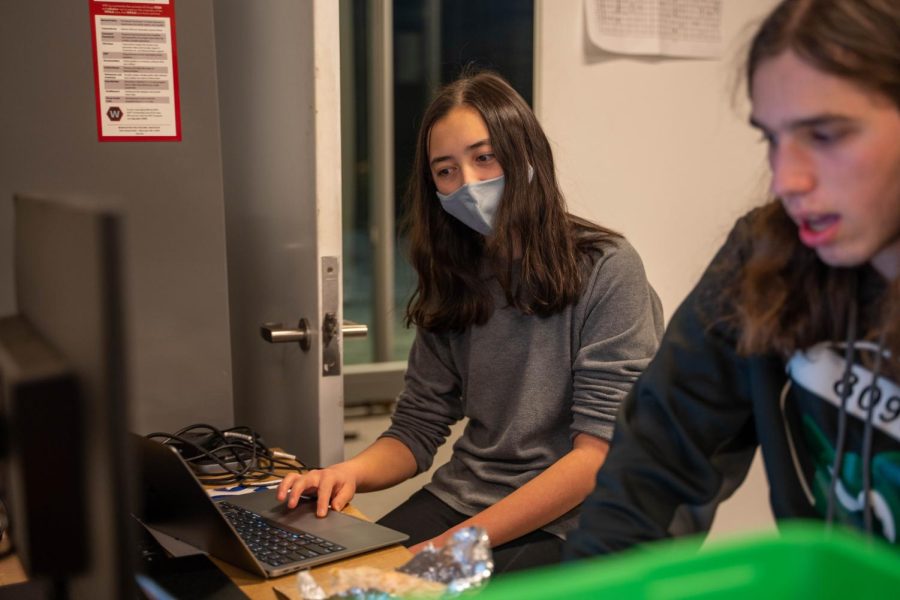Robotics club looks to construct higher population of girl participants
Despite the robotics being a male-dominated field, many girls — like sophmore Ava Kim Cohen— have had a positive experience and found their place in U-High’s robotics team.
February 24, 2023
Correction: A previous version of the article mistated the age of the robotics team, it is three years old, not five years. The photo caption also incorrectly referred to Ava Kim Cohen as Clara Cui. Edits made April 12 at 10:25 am.
After the school day ends, Room N227 at the east end of the second floor of Gordon Parks Arts Hall comes alive with activity. The double doors with the logo of the U-High robotics club open for students on the club’s three teams to tinker with the robots, write code or design parts with modeling software. Conversation flows across the room, equal parts joking and problem solving.
Since its inception three years ago, the robotics club has become one of U-High’s biggest clubs. While girls have played a valuable role in the club’s leadership and activities, and they are regarded by the advisers and their peers, the club has not achieved equal female representation, so the robotics teams are making an effort to get more girls involved.
The girls who do join robotics discover an extracurricular activity they are passionate about and willing to commit significant time to.
“As soon as I got in I just fell in love with it,” said junior Clara Cui, one of the main builders and designers on the team Cache Money, “because it’s really fun and you get to learn a lot, and I enjoy the team aspect of it.”
Girls on the teams are also appreciated by the mentors. Darren Fuller, the club’s faculty adviser, wants more girls on the team because he feels adding more perspectives is necessary to improve the club.
“They’re awesome, they’re fantastic, I want more of them, I want to clone them,” Mr. Fuller said.
Despite positive experiences, girls don’t make up half of the participants.
“I know a lot of girls are scared to go into STEM fields because it’s been historically male-dominated,” Clara said.
This is not just an issue for the club, but in general in science, technology, engineering and mathematics fields, where women are traditionally underrepresented. According to the U.S. Bureau of Labor Statistics, women comprise only 16.5% of engineers and 25.2% of computer scientists, the fields that have the most overlap with the skills learned in robotics.

The issue may lay more with society itself than the culture of the club or Lab. Kelli Van Antwerp, an outside mentor who started working with the club this year, has noticed U-High has a better culture around girls in STEM than other schools where she’s worked.
“The thought that engineering isn’t for women, that it’s mainly a boy’s club — that invisible barrier that honestly doesn’t exist here at Lab,” Ms. Van Antwerp said. “Stops a lot of people from even coming inside.”
To increase awareness of the club, and STEM in general, among younger Lab students the robotics club partnered with Girls Who Code in the middle school on robotics workshops. Teresea Serangeli, a club mentor who is an academic specialist in the lower school, has asked other teachers to show their classes robotics competitions. The club recently hosted a competition for lower school students to submit designs of a robot that would crush cans. The winners were announced at a lower school assembly on Jan. 19: third grader Meera Malik, fourth grader, Mohmaed Werdyani and fifth grader Nina Saratovsky.
The goal of all of these initiatives is to get more people, especially more girls, in the door for middle and high school robotics.
“I think it would be fun,” Nina said. “I’m not sure if I have time, but I’d like to.”
Friends Ava Cohen and Sophia Picciola started robotics last year when they entered high school.
Both are coders who together have gone through the process of learning the essential skills. Last year, the two were trying to get an autonomous period, the part of a robotics match where the robot is only controlled by code, to work but couldn’t figure out what the problem was.
“The reason why it wasn’t working was because our battery was losing power every time. And so our autonomous code was more off and off each time. We couldn’t figure out why,” Sophia said. “We kept trying to, like, fine tune it and then we figured out the issue, and then we fixed it so that it worked. And that moment stood out to me.”
Not all girls who started robotics last year stayed with the club. Ava said this is a normal part of people trying things to see what they like as they go into high school.
Improving the representation of girls on the team will benefit everyone. More girls will also get the experience working on a multifaceted team-based STEM project.
“The teamwork aspect of it is really what I find interesting,” Sophia said. “I think it’s really amazing that everyone on the team has so many different skills that get put together to make something.”




























































